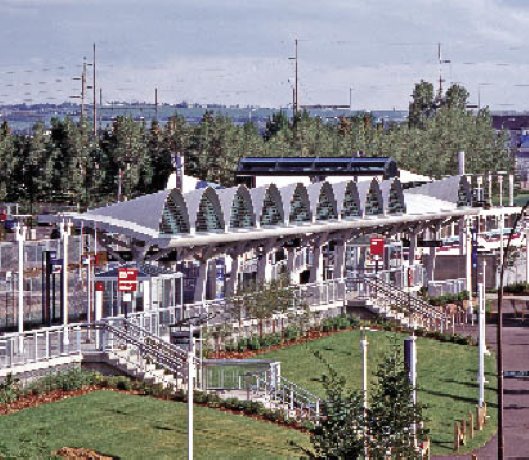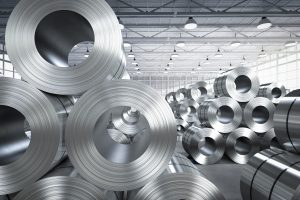The most recent award is a Federation Internationale du Beton Award for outstanding concrete structures. Among its earlier honors is the Charles Pankow Award for innovation presented this spring by the American Society of Civil Engineers. The project also marks several ‘firsts’.
TECHNOLOGY
Light rapid triumph
Calgary light rapid transit station garners praise for use of a new precast material to shelter the structure with lightweight canopies
Correspondent
Accolades keep rolling in for Calgary’s Shawnessy LRT Station, which has been in operation since June 2004.
The most recent award is a Federation Internationale du Beton Award for outstanding concrete structures. Among its earlier honors is the Charles Pankow Award for innovation presented this spring by the American Society of Civil Engineers. The project also marks several ‘firsts’.
The focus of all the praise is Shawnessy’s exceptionally thin canopy system fabricated with a relatively new precast material, Lafarge North America’s Ductal.
Part of Calgary’s LRT extension, Shawnessy is an open, ground-level station. Twenty-four canopies – curved, shell-like structures – shelter the platform. Six metres long, 5.1 metres wide and just 20 millimetres (less than an inch) thick, the canopies weigh in at two tonnes apiece. Tension tie beams join the shells together.
Each canopy is supported by three structural arms (struts) fanning out from single columns, explains Vic Perry, vice-president and general manager, Ductal, at Lafarge. Jadwiga Kroman, senior structural engineer at the City of Calgary’s Transportation Infrastructure Office, compares the appearance of the columns and struts to a tree trunk and branches.
The shells, columns, struts, tie beams and rain gutters were fabricated from Ductal. In total, approximately 80 cubic metres of Ductal went into the project.
There’s no reinforcing steel in the thin shell Ductal elements. Steel is limited to the stainless steel connections within the struts, columns and ribs.
You can call Ductal a new, unique kind of concrete, or you can call it – as Perry does – an “ultra high-performance fibre-reinforced cement composite.”
The uniqueness of Ductal technology lies primarily in the way the raw materials are proportioned, he says. The selection of materials, including fibres and super plasticizers, and the mixing and curing procedures add to the product’s uniqueness. Fibres can be either organic – polyvinyl alcohol (PVA) – or metallic. PVA fibres were employed for Shawnessy; steel fibres are used for bridge structures and other applications such as anchor blocks.
In addition to being the first project to feature thin-shelled Ductal canopies, Shawnessy also represents the first time Lafarge’s Calgary precast plant used injection molding on such a large scale. Adopted from the plastics industry, injection molding was necessary because of the high volume of fibres in Ductal.
Ductal elements are typically 20 to 50 per cent thinner than conventional precast concrete, but their delicate appearance belies their superior strength. Compared to a house basement, Ductal is 10 times stronger in compressive strength and five times stronger in flexion, Perry says.
No rebar is required for fabrication of Ductal architectural pieces. The absence of rebar is what enables complex shapes like Shawnessy Station’s curved shells.
Prestressed cable is used for projects, such as bridge girders, in which there is high structural loading.
As its name suggests, Ductal is ductile (flexible). That means, Perry explains, that Ductal structures are able “to bend and deform without destructing or shredding.
“It may micro crack, but the fibres hold the material together.”
Ultimately, Ductal will fail from too high a load but, because the deformation and deflection will be visible, measures can be taken to avert the problem, he points out.
Due to its ability to absorb a lot of energy, as from a blast, and resist shattering (pieces flying off) Ductal has found favor in vaults and other security applications, Perry reports.
Other applications range from flowerpots to bridges. A 1997 pedestrian bridge project in Sherbrooke, Quebec, marked the first North American use of Ductal.
Shawnessy station’s curved canopies were initially designed in steel. After researching Ductal technology, the city and the architect concluded design goals could be achieved with the new material.
Major owners of public infrastructure have a role to play in giving new technology a boost, Kroman suggests. “We wanted to support new technology,” she comments. “We see a lot of future in it.”
Although, in terms of up-front costs, there was a premium in electing to go with Ductal, Kroman points out that because of low maintenance requirements and expected longevity, embracing the new technology will prove economical in the long run.
“In terms of life cycle cost, we don’t think we paid a premium,” she comments.
Canopy cost, including installation, was $1.2 million; total project cost, $4 million.
Yet another first for the Shawnessy project was the use of the University of Calgary’s new Calgary Centre for Innovative Technology. At the centre, testing of a full-scale prototype canopy for wind and snow loading confirmed and surpassed predictions about the behavior of the canopies, with minimal adjustments required.
The City is the owner of Shawnessy Station and its Transportation Infrastructure Office managed the project. Stantec (which acquired CPV Group Architects and Engineers Ltd., the group originally retained) is the architect and engineer of record. Speco Engineering provided engineering consultation to the city. Walter Construction Ltd was general contractor.
Lafarge supplied the Ductal and fabricated the precast elements. Strudes Inc of Montreal provided structural design of the Ductal components for Lafarge.
“We wanted to support new technology. We see a future in it. ”
— Jadwiga Kroman, City of Calgary Senior Structural Engineer, on the use of Ductal











Recent Comments
comments for this post are closed